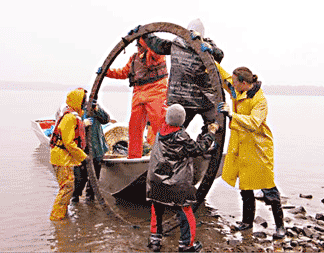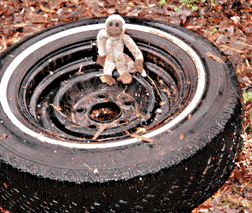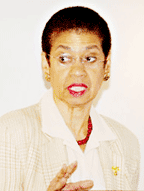 |
|||||||||||
|
|||||||||||
|
|||||||||||
Breaking the Litter-pick-up
|
|||||||||||
 |
If you don’t set an ambitious goal, you’ll never achieve it.–U.S. Rep. Chris Van Hollen |
Bowen — whose group nicknamed themselves Trash Babes and Trash Hunks — and her Council gathered together consultants, recycling experts, solid waste managers, scientists, students, councilmen and women, engineers and watershed defenders. Many have spent their Saturdays pulling trash from the rivers’ banks. Others just hate the thought of litter cluttering up waterways.
“We all know this is an issue,” says Bowen, the intense and passionate matriarch of the movement. “The next step is figuring out how to fix it.”
Digging at the Roots
The Potomac River watershed is home to 4.6 million people — 3.7 million of whom live in the Washington, D.C., metropolitan area. Each year, each person uses about 200 pounds of plastic, the most enduring culprit.
Some 100 million tons of plastic are produced each year, and about 10 percent of it ends up in the sea, according to Greenpeace.
Litter comes from sources predictable and unpredictable. Careless citizens toss their fast-food bags, empty soda cans, coffee cups and cigarettes from the windows of their cars. Accidental litter blows from trash trucks barreling down the Beltway or garbage cans overflowing after a street festival. Boaters lose sandwich bags and rope overboard. Illegal dumpers litter with the oddest things — like that refrigerator and two toilets along roadsides and in riverbeds. The scope of illegal dumping ranges from a soda can out the window to industrial releases of toxins into storm drains.
From these many sources, a steady stream of litter trickles into our waterways.
Last summer, the Anacostia River was listed under the Clean Water Act as a river impaired by trash, in both Maryland and D.C. That dubious distinction made the Anacostia one of two rivers in the nation in the most desperate need of trash removal, along with a tributary to the Los Angles River.
The Bay may not be trash-impaired on paper, but litter blankets the Chesapeake’s lands and waters.
Each spring at the annual South River Cleanup’s five sites, South Riverkeeper Drew Koslow measures the haul by the truckload — the big county dump-sized truckload.
From the Church Creek ravine at the urban intersection of Route 2 and Forest Drive, from Annapolis Harbour Center past Woodbridge Center to Forest Plaza, “we filled up one and a half dump truck loads and also pulled out 52 car batteries,” Koslow reports. A truckload and a half of trash is an improvement hard won over five cleanups.
“Just the volume is shocking,” Koslow says.
Another site behind Blockbuster in Forest Plaza, off Forest Drive, yielded two large trailer loads — maybe 10,000 pounds of stuff, Koslow guesses. Among the oddities were a safe — containing nothing — and a couple of old bicycles.
“What I don’t get is, it’s free for county residents to go to the dump. They already have it loaded in their vehicle. All they have to do is drive another 15 minutes,” he says. “And it’s free.”
On the South River, litter is an aesthetic problem, worse at hidden spots — like the ravine — that make easy dumps. It’s also a social problem, testifying to a careless society that takes the easy way out of managing the whole spectrum of its wastes. At the Church Creek site on Rt. 2 and Forest Drive, it’s also testimony to another kind of social problem, for this is an area where people who are homeless camp. Their presence explains not only the easy chair the South River crew pulled out of Church Creek but also the 52 car batteries, carried in to provide energy. The abandoned batteries could pose a greater problem if their acids leak out.
Litter threatens not just our ecology but throws grim realities of a careless society in our faces.
“When an area looks trashed, it affects our quality of life, how we feel about where we live. Trash detaches us from our surroundings,” Koslow says. “It’s a reflection of how we view our natural resources in our community.”
Way Downstream
Water from the Potomac River’s 14,670-square-mile watershed drains into the 383-mile river that runs from West Virginia to Point Lookout in St. Mary’s County. Seven billion gallons of water flow through our nation’s capital’s waterway each day.
Unless a volunteer seizes a plastic water bottle or plastic netting from the Potomac’s waters, it keeps floating downstream. Trash that washes through the Potomac — and other regional rivers — flows to the Chesapeake Bay, then to the ocean.
“A lot of crap ends up in the Chesapeake Bay, so it’s impossible to have a great interest in one river and not the others,” said D.C. delegate Eleanor Holmes Norton, who joined 40 others at the Trash-Free summit in signing onto the trash treaty.
In a classic tragedy of the commons, single-minded selfishness spoils the common good.
“The Earth is our living room, and we shouldn’t junk it up,” says oceanographer Sylvia Earle. Earle, who has logged more than 6,000 hours underwater and has led some 60 expeditions, helped rally the audience at the Trash-Free summit.
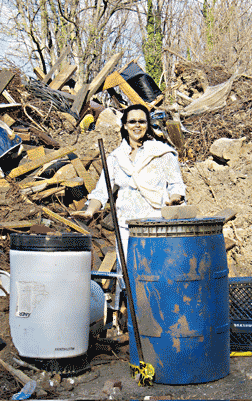 |
Fixing the litter problem isn’t just “about public education,” says Tracy Bowen, executive director of the Alice Ferguson Foundation. “Human beings need incentives to change behavior.” |
By Earle’s analogy, the Chesapeake and our local waterways are our couch and easy chairs.
“Trash I see on the Bay has to come from somewhere upstream,” said Capt. Kenneth Barton, director of NOAA’s Office of Response and Restoration.
Somewhere downstream, casual discards can be fatal.
Sea birds swallow tiny pieces of plastic, which clog their system for the rest of their lives. Earle showed a photo of a dead albatross, its stomach cut open to reveal a dozen small plastic pieces: bottlecaps, packaging parts, balloons and more.
The albatross, the largest of seabirds and much beleaguered in our times, flies vast distances in its search for food; some species span the globe.
Ocean currents that circulate in the Northern Pacific create a gyre of swirling trash, known as a trash vortex.
“Why do we think this is an okay behavior?” asked Earle, who says she worries about getting tangled up in debris when she ventures out on a small exploration submarine.
Once, a mile under the ocean’s surface, she saw a glimmer of light. Following it, hoping to make an important discovery, she discovered an RC Cola can.
Getting people to care enough to not toss that can out the window means re-programming them to think about their actions and the consequences in the natural world.
“The Earth is not able to accept all of the insults we offer to it,” said Earle, who remembers a world before plastics became commonplace. Now, floating plastic — and beached plastics — persist in environments from the Pacific Islands to the Atlantic depths. “It winds up clogging the arteries of the planet,” she said.
Cleaning Up Our Act
“We have to approach this in a systematic way and a holistic way,” Bowen advises in her campaign to curb — and extinguish — the litter problem. “It can’t just be about public education. Human beings need incentives to change behavior.”
Incentives can be both carrots and sticks. Bigger sticks — like higher fines for littering and prohibiting trashing of recyclables — would help force us to clean up our act. Under Maryland’s Litter Control Law, you could face a $1,000 fine for throwing garbage out your car window — if you get caught.
But enticing us with carrots, perhaps even paying us to return our waste to the proper place, may get more people to take action.
If trash had value, the thinking goes, people wouldn’t throw it away. Instead, they would collect it and cash it in.
“The greatest number of items I recall seeing are these plastic bottles,” says Potomac Riverkeeper Merrifield, who supports a bottle bill. Such a law would tack on an extra charge — like 10 cents — for plastic and glass containers that people could cash in on returning the container.
Maryland tried to pass a bottle bill in this year’s session — the last major effort failed two decades ago — but it failed again. Eleven other states have bottle bills; seven states, including Maryland, are pushing for such a law.
“It’s thinking, what does it take to get me to take my tire to the right place?” said Elizabeth Rice, a consultant for the Baltimore Community Foundation, at the Trash-Free summit. “For $10 a tire, I would.”
Companies are getting creative in putting value on our trash.
Envirelation, a composting hauler, gets client companies to put food waste in special bins placed in their kitchens. Then, Envirelation founder Walker Lund and his staff make rounds collecting the food scraps from businesses around the D.C. metropolitan area. “If it grows, it goes,” Lund says.
Lund’s business solves not only a waste problem, it also protects our waterways from sewage overflow.
“In D.C., if you have a restaurant, food service or grocery store and you have sewer pipes, the food code requires you to put food scraps into the sewer system,” explained Lund. Meant as a pest-prevention measure to keep varmints out of landfills, the influx of food waste takes up space in the sewer treatment plants. That’s completely unnecessary, Lund said.
A lot of crap ends up in the Chesapeake Bay, so it’s impossible to have a great interest in one river and not the others.–D.C. Del. Eleanor Holmes Norton |
|
Increasing the load on a sewer system raises the likelihood of an overflow, which can release untreated sewage into rivers. Sewage in the rivers releases bacteria that can hurt wildlife and people.
Now, Lund’s company hauls five to 10 tons a week — 290 tons last month — to Chesterfield Farms, a 6.5-acre site in Crofton where large-scale composting breaks down tons of organics.
Locally, The Rockfish bar and grill in Eastport ships its food waste to Chesterfield Farms.
As it stands, this waste makes up roughly 25 percent of our municipal solid waste nationwide.
Both the World Bank headquarters and the Four Seasons Hotel in downtown D.C., used to toss food scraps into the waste stream. Now, Lund hauls organic waste from both establishments — some 35 to 40 percent of waste from the Four Seasons — to Chesterfield Farms’ composting farm. Anne Arundel County’s curbside yard trimmings pickup, plus Whole Foods’ leftover fruits and vegetables, head to the farm as well. Not just any business can commit their organics wastes to Chesterfield. Only businesses that pass the farm’s tests for having a reliable, consistent medley of organic scraps get to send their waste.
“It’s saving them [the businesses] money by not paying a hauler to haul it away. It’s cheaper to separate their food and have it hauled to the compost site than to the landfill,” Bowen said.
So far this year, Chesterfield Farms has brought in more than 2,500 tons of food waste.
Chesterfield Farms, one of only a few private composting sites of its kind on the East Coast, produces some 12,000 tons of compost a year. The organic and yard waste is heated to 140 degrees, then rotated for over 90 days. The cooked compost becomes the base for its EcoSoils — soil mixes, including clay loam, compost, lightweight aggregates, topsoil and vermiculite — marketed to local nurseries, garden centers and community gardens. Some of their soils are used on green roofs and for bioretention in stormwater management landscapes.
Here on the East Coast, we’re just catching up with Europe and the West Coast, says Marsha Boehm of Chesterfield Farms.
“We have a lot to do to educate people about composting,” she says.
Trash-Free Dreams
We can wield our power as consumers for the greener good.
“It’s not unreasonable to expect legislation that bans Styrofoam,” Dan Nees of the World Resources Institute, told a roundtable of recycling and waste representatives from around the D.C. metro area.
The City of San Francisco passed such a ban in 2006, forbidding all polystyrene foam disposable food containers at restaurants and food vendors.
San Francisco also amped up its recycling rate to 65 percent, with a goal by 2010 of 75 percent. Jack Macy, Commercial Recycling Coordinator for the City of San Francisco, spoke to Summit-goers via satellite to offer suggestions and encouragement.
The city has “helped to create an infrastructure to accommodate these changes, with composting and other services,” Bowen said. “So what’s really important is for the local government to work collaboratively with the community.”
Another prime item of litter, plastic bags, must be either biodegradable or reusable in the Golden Gate city. Producing plastic bags uses more than 12 million barrels of oil each year, according to the San Francisco Department of the Environment; littered bags cause the death of over 100,000 marine animals each year.
Inspired by San Francisco, Annapolis is debating a plastic bag ban of its own.
City Councilman Sam Shropshire is leading the discussion, saying that a citywide ban on plastic shopping bags would save oil, prevent pollution and decrease nuisance litter along road and waterways.
“A short boat trip down Spa Creek or Back Creek or out onto the Bay will prove the need for banning plastic checkout bags,” Shropshire wrote in an email. “It’s about what’s right for the health of the Chesapeake Bay and its tributaries.”
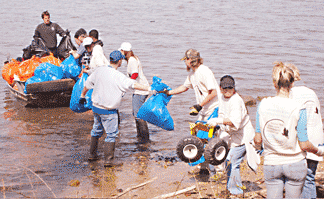 |
Volunteers last spring hauled out 2,649 tires, 69 50-gallon drums, 26 shopping carts, five car batteries, four mattresses and one refrigerator in the 19th annual Potomac River Watershed Cleanup. |
Opponents counter that recycled paper bags are more expensive than plastic, which also serve better in transporting cold, condensation-wet products, like milk.
Shropshire keeps the bigger picture in mind. “Our proximity to the Chesapeake Bay mandates that we go to reusable and recycled paper bags,” he told Bay Weekly.
He will introduce his bill in the city council’s July 9 meeting. Then on July 23, the bag-ban bill comes up again for public hearing.
“It’s going to pass,” Shropshire said. “I’ve already got five votes and that’s all I need.”
If we must have plastic bags, perhaps they should be biodegradable — made of sugar, corn or potatoes. If such a bag sailed into a waterway, it would break down in time, unlike its plastic counterparts. Biodegradable bags are more expensive and account for less than one percent of the market, though as more green consumers learn about and use them, prices will go down.
Outlawing Trash
We should also expect our government to control trash flowing into our waterways, making adjustments to curb litter and rogue garbage.
One major action our governments can take is to stop litter from flowing through storm drains and into rivers.
“A lot of the trash is coming from storm drain system,” Bowen says.
Counties and cities — smaller governments — can keep trash from entering storm drains with more frequent street sweeping, targeting trash hotspots and stepping up litter pickup at trash sources, like convenience stores, Bowen says.
But our state and federal governments have responsibility at a larger level. Maryland Department of the Environment and the U.S. EPA are supposed to guard our rivers and waterways from pollutants. Those agencies are now agreeing that trash is a pollutant, Bowen says.
A short boat trip down Spa Creek or Back Creek or out onto the Bay will prove the need for banning plastic checkout bags.–Annapolis Councilman Sam Shropshire |
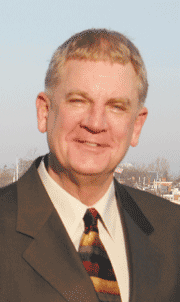 |
Recognizing trash as a pollutant means the EPA will have to establish trash-controlling rules, just as it does for other pollutants. Total maximum daily load is the term set for the number of pounds allowed to pass into a drain on any given day. Setting limits seems counterintuitive to the goal of eliminating trash, but it has benefits, including giving governments a yardstick to measure the problem and — eventually — solutions.
The Anacostia will soon get that attention, a result of its listing by the EPA as a river impaired by trash in its entire watershed. The EPA is beginning to set load limits for trash entering storm drains. With eastablished limits, counties could set goals to reduce trash entering the storm drain — for instance, 15 percent less trash each year — until governments allow zero waste into the drain by 2013.
Trash-busters are pushing for such trash-loading limits on county storm drain permits, another avenue that could lead to load limits on trash.
In Montgomery County, that permit — which allows stormwater to run from county streets to the state-owned municipal stormwater drains — is up for renewal. When it’s renewed, officials will write a total maximum daily load for trash into the permit. Prince George’s County may have their permit opened up mid-contract to do the same.
The Foundation hopes that other counties outside of the Anacostia watershed will soon follow.
The expectations that we place on ourselves — how much trash is acceptable to pass into waterways — will define our future. And the future of our children — who will have to contend with our plastics of today.
As Earle says, this is our upstream contribution to our downstream heritage.
Living in a Material World
To get our millions of neighbors to take trash seriously, we’ll have to change the way we think about trash.
When carmarkers first were required to install seatbelts, people hated the idea. Now seatbelts are the standard. The public mind was changed by both a dangling carrot (safety in crashes) and a stick (fines if you get caught without a seatbelt).
If we want to live in an unpolluted world, we’ll have to make changes just as deep.
We’ll have to change the way we keep house and do business. We’ll have to figure out how to teach the litterbugs not to toss trash. We’ll have to spend a little extra time getting reusable cloth bags out of the trunk of our car before we grocery shop. Our businesses will have to figure out how to use less packaging on products.
Extra effort may take time, but benefits abound.
If we can curb our sheer amount of waterway litter, we’ll start to solve worse problems down the road.
For more information about how you can join in the Trash Free Potomac by 2013 crusade, visit www.TrashFreePotomac.org.
|
Current Issue \\ Archives \\ Subscriptions \\ Clasified Advertising \\ Display Advertising |
© COPYRIGHT 2007 by New Bay Enterprises, Inc. All rights reserved.

